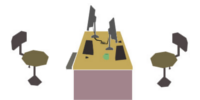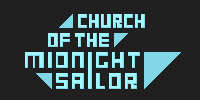Interview: Signalis’ Alex Zwerger
As a third-person survival horror experience using low-poly 3D models and 2D sprites to create pixel-perfect visuals, rose-engine‘s Signalis makes aesthetic choices that turn heads and create intrigue. Remote, snow-covered planet? Check. Ruins of an underground labor camp? Check. Cosmic horror? Check. Thanks go out to developer Alex Zwerger for chatting me up and fielding my varied questions, and a suggestion to readers: if you don’t already have the word ‘retrotech’ in your vocabulary, add it.
Erik Meyer: Signalis bills itself as a dystopic/sci-fi horror experience in which melancholic mystery plays a big role, a description that speaks to mood and aesthetic, so can you talk about the narrative elements and the specific, in-game details that contribute to the universe you’re creating, the way in which you position the lens we see things through? What is it that fills us with nostalgia and melancholy, and as developers, how do you avoid hitting players over the head with your style elements?
Alex Zwerger: Quite a tough question right at the start! To me, at the heart of every piece of artwork lies the question: “How will this make me feel?” – what kind of emotional reaction might this create in an invested observer? This applies to any kind of artwork I set out to make – be it illustrations, concept art, comics, or games.
For Signalis, it was a mysterious introspective sadness, as one might experience looking out onto a foggy sea or seeing a familiar object weathered and broken by time.
The hope to fill players with these kinds of feelings as they play our game guides the writing and art for Signalis. Elster, our protagonist, must uncover the past as she wanders a plane between dream and reality. But both in dreams tinted in subjectivity and in a totalitarian regime, what should she believe?
We believe strong, detailed world-building and a story with a small cast of complex characters will be able to evoke these feelings without hitting players over the head. I feel this is the key to a good mystery – being able to give every detail meaning the audience can deduct, but never simply explaining the meaning. I feel it’s what separates a movie like Lost Highway from Jacob’s Ladder. Both movies have a mysterious feeling full of symbolism to them, but one of them gives away everything with its ending, while the other keeps us guessing, staying with us long after the credits rolled – yet, it never feels like anything in it was meaningless or random.
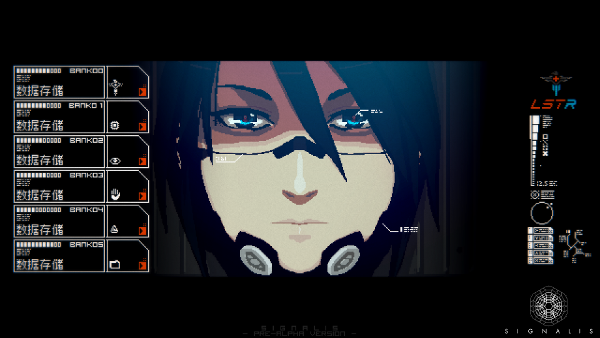
EM: Your project combines 2d and 3d elements, using pixel art while also having menus that show close-up views of rotating rendered weapons, so from an asset creation standpoint, what holds these things together and gives them a home in a single game? If the screen is a visual landscape, what is your philosophy behind visual balance and art styles?
AZ: This is where we get a little technical. While we always wanted to use 3D elements in Signalis, previous prototypes had always been nearly exclusively 2D for technical reasons. It was only about a year ago that we took the leap to 3D, starting with the rotating item views in the inventory screen, before we switched to 3D animation to enhance character animations. When we started implementing 3D assets, our highest priority was to always get as close as possible to the look we had already created with 2D assets. We liked the way the game looked, we just wanted to enhance its motion.
One way we do this is by strictly sticking to a 640 x 360 pixel resolution. Everything in the game is rendered at this resolution before it’s upscaled to final game resolution. Just like the sprites, the 3D objects must stick to this limitation, matching their level of detail.
The advantage of working in a team as small as ours is that nearly all of the key art is done by one person. Signalis’ art style – graphic, minimalist, technical, anime-inspired retrotech pixel art – is a direct result of my personal art style. In the end, that’s what keeps it all together.
EM: Two things I’m always interested in are the levels of technology present and the differences in society, as experienced via the protagonist. I’m aware of the fact that Elster has crash-landed on a snowy planet and discovers an abandoned underground labor camp, but as the game takes on larger concepts like cosmic horror, I’m curious: Beyond the ability for space travel, what other technical achievements separate Elster’s reality from our own, and similarly, when it comes to social values, what maintains itself as ‘normal’? As you create the mythos for your game, how far do you go down these kinds of rabbit holes?
AZ: We don’t want to hit people over the head with our world-building, but we do love going down the rabbit hole, so there will be a lot of specific details about the society and their technical achievements to discover in the game.
I’m a big fan of science fiction and one of those annoying people who loves poking at the holes in the world-building of the books and movies I consume, so a lot of the world-building for Signalis is a result of my own questioning of the logic of the world we are creating for the game.
Signalis does not take place in our future, but in a different reality – with its own timeline.
The level of technology in this universe is comparable to that in the original Alien movie: delightfully ancient CRT monitors and chunky cartridges handled by lifelike androids.
What’s entirely different is the society. We’re both big fans of the Alien franchise, but we realized that it, like a lot of modern science fiction, is strongly tinted by present-day American society. This influence permeates nearly every detail: from the strong role greedy corporations play in these stories, to terms like “colony”, “space marine”, and even the packaging of everyday products.
We wanted to create something distinct from that, so we looked for inspiration in different places.
From a longing to bring more of my own identity into the game’s world came the idea of a setting inspired by Eurasian (particularly German and Chinese) culture and history. Since we’re making a horror game, we especially looked a lot at the darker parts of that history (and in some places, still the present): totalitarian states and forced labor camps. We draw a lot of ideas from our research into these topics and I think it’ll bring an interesting context to the characters and the events unfolding in the game.
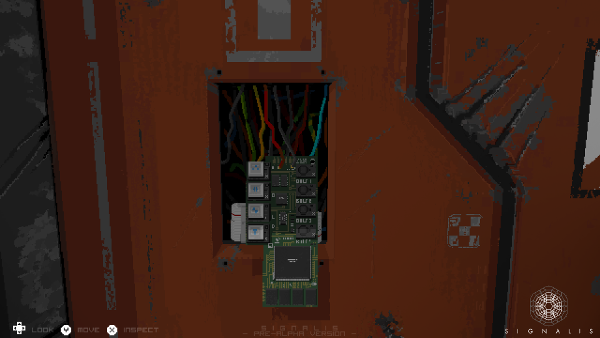
EM: Puzzles in the game include breaking codes, using radio signals, and combining objects, which begs the question: what makes for the most satisfying puzzles? And further, within the context of a videogame, when do puzzles work well, and when do they feel forced/excessive? As a designer, what kinds of thoughts go into this aspect of Signalis?
AZ: I really wish I knew the answer to what makes the most satisfying puzzles. I feel like this probably differs greatly from person to person, from their own experiences with puzzles, and their willingness to commit themselves to solving a particular mystery. The same goes for when puzzles start feeling excessive or forced.
For me, an essential part of a good puzzle is a problem that seems hard to solve, but where it’s easy to confirm if you’ve solved it correctly, similar to a Rubik’s Cube or a Sudoku. While the game will of course tell the player if they’re right, they should already know that they’re entering the right solution. That’s the moment when I feel excited during a puzzle. Another great feeling is when clues that seemed unimportant before acquire new meaning through a change of context.
Ideally, puzzles aren’t just an obstacle in the progression of the game, but in themselves are part of the storytelling and world-building of the game. The way a puzzle is presented can tell a story, or simply convey a certain mood by the kind of imagery it uses. They can become as much part of the narrative as cutscenes and dialogue are.
Varying the types of puzzles and pacing them right is of course an important aspect to avoiding fatigue. If there’s a complicated, multi-step puzzle in an area, we try to have a few easier ones nearby that the player can solve along the way so some progress is still made while working on the bigger puzzle. It’s important to avoid that feeling of running against a wall with no alternative routes.
EM: From prior correspondence, I know you’re taking your project to events like A MAZE in Berlin, so as you put your work out into the world and interact with other devs, gamers, and the press, what kinds of responses have you been getting? Additionally, as a small studio, what do you see as keys to success in the areas of marketing and engagement?
AZ: We’re very lucky to have had the chance to show various prototypes of Signalis at events like PAX East and A MAZE Berlin this year. We were extremely nervous to show the game to the gaming public, but the feedback has been extraordinary. People were very kind and supportive. We’re both reclusive artists and perfectionists, and after working on the game by ourselves for years, it’s very helpful to hear other people’s perspective on it. The most common feedback was definitely that people loved the unique visual aesthetics. We were very surprised by how many people apart from ourselves are interested in a game that goes back to the roots of old-school survival horror, and also how many people who don’t share our nostalgia for that genre were still enjoying the demo.
I wish I knew what the keys to success in marketing for small studios is. For us, so far, posting content regularly and frequently has been the most important part. We’re still trying to figure out the rest. The hardest part is getting people to notice you in the vastness of the internet. The most common question at events we get is “how have I not heard about this game before?” and we don’t really have a good answer to that.
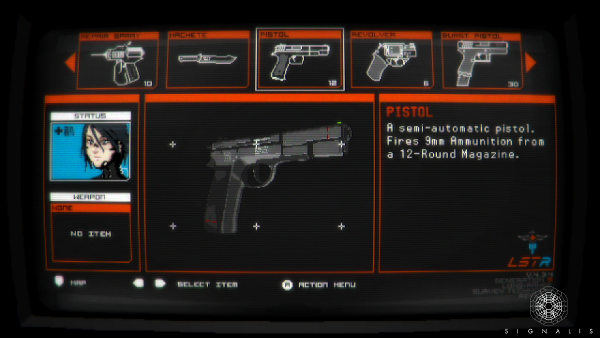
EM: You live and work in Hamburg, Germany, so how do you see your location playing a role in your work? Ich war ein Fremdsprachenassistent vor fünfzehn Jahren in Eppendorf, and I remember the city being a bustling hub of creativity, but how do you see the where aspect of work playing a role in what you’re doing?
AZ: We both moved to Hamburg a few years ago to study illustration design, and there was a course in game design we both immediately felt excited about. We were always interested in making games but had never done anything beyond making small personal mods for existing games. The course gave us a good excuse to spend all our free time on learning how to make our own games.
This probably wouldn’t have happened in other places. We were also lucky to be chosen by local games curators several times to be included in gaming exhibitions in Hamburg. There’s an amazing community of indie developers in Hamburg and we’re very glad to be part of that.
Financially, Hamburg might not be the ideal location for indie game development, though. Unlike in many other German states, there’s no public funding available for games here, even though some of the largest game companies in Germany reside here.
EM: Ascend and Coffin Counseling represent previous projects, so can you describe the lessons/strategies/skills that come from your past work? And what kinds of things has prior work with illustration brought to the current tasks at hand?
AZ: With each game, we’ve set out to accomplish different goals. Ascend was very much about creating a game with a high in-game difficulty in a very short production time. Coffin Counseling was about working with strict limitations on graphics and writing. With each game, we’ve learned a lot of practical skills about producing games, including programming, asset creation, and using the Unity3D engine.
We’ve also learned the advantages of working in a small team.
Our background in illustration and comics shapes the way we think about our games, especially Signalis. We work very visually oriented, especially in the early stages of planning, focusing a lot on the style and mood of the games we’re working on. For me, it’s usually easier to express an idea in a picture rather than words.
EM: As you look ahead in 2018 toward a Kickstarter and check things off your task lists, how do you see your pipeline and daily work flow changing? Do the more technical elements, like debugging or optimizing for a specific platform take on a larger role, or are you still working through narrative elements?
AZ: Right now we’re still working on our latest prototype and a new trailer more representative of the final product. Debugging and optimization took a large role before we showed the game at PAX and A MAZE, but right now we’re back to working on some core features that we couldn’t show at those events as they weren’t polished enough for public showcases. With a potential Kickstarter on the horizon, we’ll also have to focus a lot more on how to present the game to the public in a short, appealing, and concise manner. Signalis is a lot of things to us, it’s a multi-layered, slow-paced, atmospheric narrative experience, and that’s a hard thing to present online, where the average attention span ranges in the seconds. If the Kickstarter is a success (or if we can find a publisher ), we’ll be able to focus on creating more of the content planned for the final game before we’ll return to pre-release debugging and polishing.
In case you missed it, here’s the trailer:


